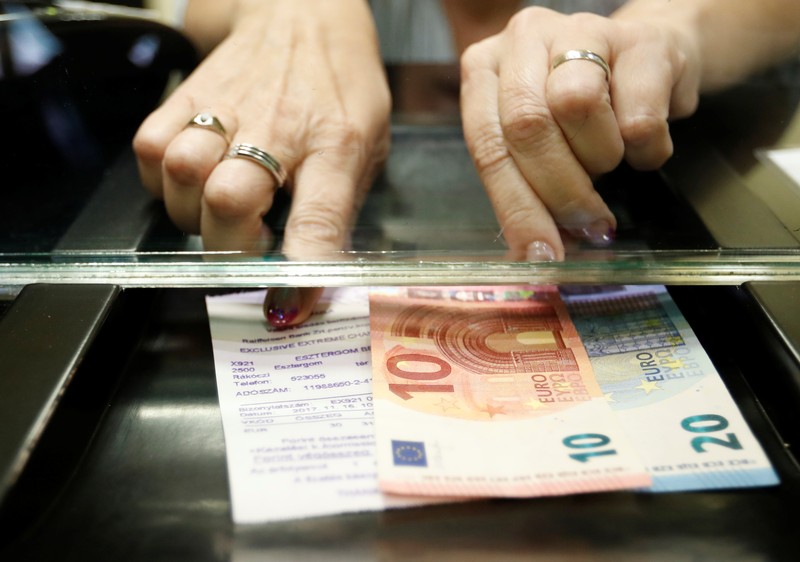
A Hungarian woman exchanges forints for euros at a currency exchange shop in Esztergom, Hungary November 11, 2017. REUTERS/Laszlo Balogh
February 2, 2018
By Herbert Lash
NEW YORK (Reuters) – Stock markets plunged and bond yields soared on Friday after U.S. data showing the strongest annual wage growth since 2009 rattled investors who fear accelerating inflation will usher in more interest rate hikes than expected this year.
Yields on the benchmark 10-year U.S. Treasury note shot up to a four-year high just minutes after the release of a Labor Department unemployment report for January that underscored strong momentum in the U.S. economy.
A gain of 200,000 jobs last month and annualized increase in average hourly earnings to 2.9 percent led the dollar to surge against the yen, the euro and a basket of six currencies.
The price of the U.S. 10-year note later fell further, pushing the yield up as high as 2.854 percent from 2.773 percent late on Thursday.
The rapid rise in the 10-year note – the world benchmark for corporate lending – sent shockwaves through a market grown accustomed to low inflation and a steady tick higher in stocks.
“It feels as though the grand era of interest rates below 3 percent will soon be in the rear-view mirror,” said Mike Terwilliger, portfolio manager of Resource Liquid Alternatives for the Resource Credit Income Fund in New York.
While wage growth may be good for the economy it could spell trouble for the bond market as inflation portends rate hikes, which augur a repricing of fixed income, he said.
The spike in bond rates made everybody nervous, said Gary Bradshaw, portfolio manager at Hodges Capital Management in Dallas. But the stock sell-off was long overdue, he said.
“The correction looks a whole lot worse than maybe it is because of the fact that we hadn’t had a correction for so long that we all got used to watching this market go up,” he said.
Art Hogan, chief market strategist at Wunderlich Securities in New York, said next week investors will kick themselves for selling assets for all the wrong reasons in a sell-off akin to throwing the baby out with the bath water.
“Next week we will start sorting and saying, ‘Wait a minute. We sold financials because interest rates are going higher?’”
It was the biggest single-day percentage decline for the benchmark S&P 500 index since September 2016 and for the Dow since June 2016. The S&P 500 is still up 3.2 percent for the year.
A stock slide of at least 1 percent in Europe later accelerated on Wall Street as the strong labor market data boosted chances the Federal Reserve will raise rates four times this year instead of the three hikes analysts had expected.
“What is good for the average American worker ends up being negative for stocks because it increases the odds of further rate hikes,” said Michael Antonelli, managing director of institutional sales trading at Robert W. Baird in Milwaukee.
The Dow Jones Industrial Average fell 665.75 points, or 2.54 percent, to 25,520.96. The S&P 500 lost 59.85 points, or 2.12 percent, to 2,762.13 and the Nasdaq Composite dropped 144.92 points, or 1.96 percent, to 7,240.95.
Disappointing results from some of the largest U.S. companies also weighed on stocks. Oil majors Exxon and Chevron fell 5.1 percent and 5.6 percent, respectively, after reporting lower-than-expected quarterly profits.
Google-parent Alphabet fell 5.3 percent after an earnings miss and Apple fell 4.3 percent as investors focused on its muted forecast rather than strong iPhone prices.
MSCI’s all-country world index of equity performance in 47 countries fell 1.8 percent while its gauge of emerging market stocks lost 1.43 percent.
Deutsche Bank’s disappointing results pulled the heavyweight banking sector down to help European shares post their biggest weekly loss in more than a year, while Britain’s top share index sealed its weakest week in nine months on BT’s results.
The pan-European FTSEurofirst 300 index of leading regional shares closed down 1.37 percent and the blue-chip FTSE 100 index in London closed down 0.63 percent.
The dollar index, tracking the unit against a basket of major currencies, rose 0.59 percent, with the euro down 0.38 percent to $1.2460. The Japanese yen weakened 0.64 percent versus the greenback at 110.12 per dollar.
The U.S. bond market’s gauges of inflation expectations added to their rise. The gap between 10-year Treasury Inflation Protected Securities (TIPS) and 10-year Treasury notes reached its widest since September 2014.
Crude prices fell on the surging dollar though adherence to output cuts by members of the Organization of the Petroleum Exporting Countries and rising global demand kept much of this year’s rally in oil in place.
U.S. West Texas Intermediate (WTI) crude settled down 35 cents to $65.45 a barrel. Brent lost $1.07 to $68.58. The deep decline in Brent cut the gap between it and WTI to its narrowest since August.
U.S. gold futures for April delivery settled down $10.60, or 0.8 percent, at $1,337.30.
(Additional reporting by Sinead Carew; Editing by Bernadette Baum and James Dalgleish)

